#king pedro v of portugal
Text
Introduction
Do you have opinions on the Serene House of Bragança (or Braganza) Do you wish to join the Brigantine Dynasty as it streches from East Timor to Brazil. Do you wish to eat Caldo Verde in a hot day in Portugal. Do you enjoy seeing drama, plotting, consorts more interesting than their Bragança husbands and the glory that is coming to Brazil? If so this defunct house of rulers that has had claimants and candidates to the thrones of Greece and Poland, as well as Monarchs of Portugal and royal consorts that have provided Monarchs such as Ferdinand of Romania? Dilettantes including the Infante Manuel de Bragança? and of course the Glorious Kings of Portugal and the Emperors of Brazil? If so, come to Brazil Join the tournament to discover the best Bragança!
Listen we may not be as dramatic as the Habsburgs or the Bourbons, but in terms of drama, we are the little house that could (so much drama (the War of the Brothers, the scheming of Carlota Joaquina, João V and his strong love of the catholic church)
Rules:
Who will be included in your lists? Much like notable brackets of Central Europe, we will include unconventional figures who may technically be considered members of other dynasties including *sighs*...at least a few Hohenzollerns (But unlike the @best-hohenzollern-ruler bracket, these will be ROMANIAN HOHENZOLLERNS; which is better).
We will also include the consorts from other royal families whose ambitions, intellect, and force of will may have outshone their admittedly mediocre Bragança spouses (Carlota Joaquina of the Bourbons is fascinating as is Maria Leopoldina of Austria)
Is propaganda encouraged?
Absolutely, as Lilia Schwarcz shows for Pedro II of Brazil, propaganda and pageantry are essential for the construction of the Bragança dynasty and monarchy! As such, It is also essential for this bracket!
Why is everyone a Pedro or João?
Hey, those are perfectly good names....but we also have two Marias who reigned in their own right (Actually, a lot more Marias in this bracket!) We also have some Afonsos
What regnal numbers will you be using?
Honestly, we will be using the Portuguese regnal numbers up until Pedro II of Brazil, who will have emperor in his title to distinguish him (Pedro I of Brazil/ IV of Portugal will have both)/ We will also include a few dukes.
Which language will you be using for the names?
Portuguese....do you really want to deal with a bunch of Johns and Peters?
How would you like it if, say a Habsburg Bracket, called Franz Joseph
Francisco José? It would be weird.
What is your relation to @best-hohenzollern-ruler, @best-habsburg-monarch, and the @best-bourbon-monarch?
Much like the Duke João of Braganza ( the future King João IV of Portugal) we bravely broke off from the @best-habsburg-monarch's bracket to form our own path! However, as is our want, we deeply appreciate the Habsburgs, the Bourbons, and the Hohenzollerns. Thus, we have maintained our propensity to intermarry into each of these families and their membership has joined us as well. So @best-hohenzollern-ruler @best-bourbon-monarch and @best-habsburg-monarch, friends? Also, @rulers-of-poland-tournament, Infante Manuel de Bragança really thinks y'all are swell!
10 notes
·
View notes
Text

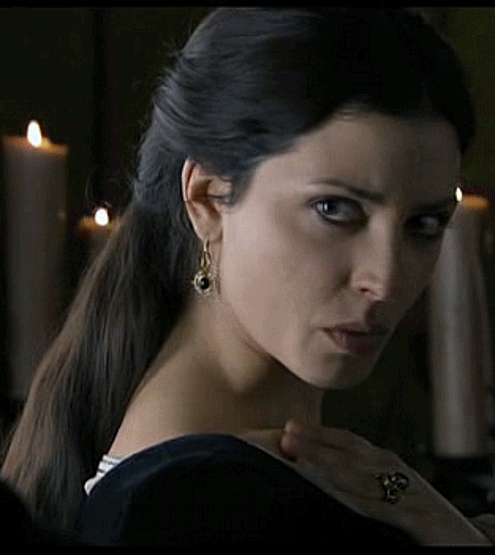

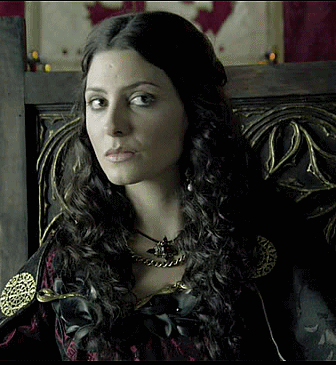
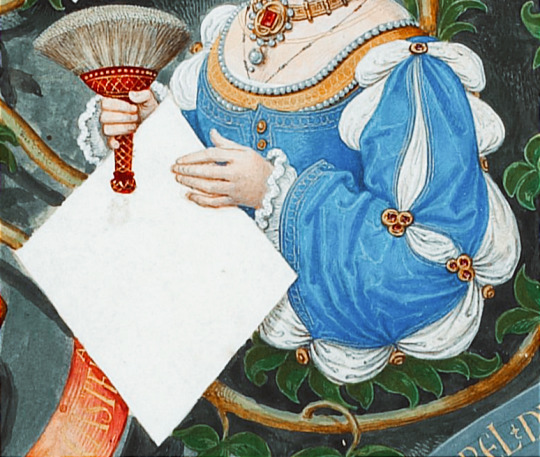
Juana of Portugal (1439-1475)
She was the posthumous daughter of King Duarte of Portugal and his wife Leonor of Aragon. Juana grew up in exile with her mother, due to the intrigues of the Portuguese court, and lived first at the Monastery of Santa María in Medina del Campo and later in Toledo, where Leonor of Aragon died. At the age of six, Juana returned to the Portuguese court of her brother Afonso V.
In 1455 the young Juana married her cousin Enrique IV of Castile, who had repudiated his first consort after thirteen years of marriage. The couple produced no children. The marriage was annulled on the grounds of an impotence that was specific rather than general, an impotence that applied only to Enrique’s relationship with Blanca of Navarre. Yet such an extraordinary explanation amounted to a case of maleficium (spell), with the clear implication that Blanca was the guilty party, and in addition she was obliged to leave Castile and return to Navarre.

Juana of Portugal was described as beautiful, cheerful and coquettish. The sources speak of the licentiousness introduced by the young Queen and her ladies in the austere Castilian court. They liked to use perfums, makeups, dresses that displayed too much décolletage, and flirting with men. One of her ladies, Guiomar de Castro, was King’s mistress, causing the anger of the Queen, and other, Mencía de Lemos, was Cardinal Mendoza’s mistress.
Six years after her wedding, Queen Juana was pregnant. Some say it was a miracle, others that it was the result of some sort of artificial insemination that the couple had tried, as was recorded by a german traveler. During this period, Juana insisted that Enrique's teenaged brother and sister, Alfonso and Isabel, forcefully be brought to the court and away from their sick mother. Many saw this as a way of making sure her daughter's path to the crown would encounter no obstacles. The Queen gave birth to a daughter named Juana, officially proclaimed heir to the Crown of Castile and created Princess of Asturias.
Queen Juana planned the marriage between her sister-in-law, Isabel of Castile, and her brother Afonso V of Portugal, and her daughter with her nephew Prince Joao. She wanted with these weddings an annexation of the Crown of Castile with the kingdom of Portugal.
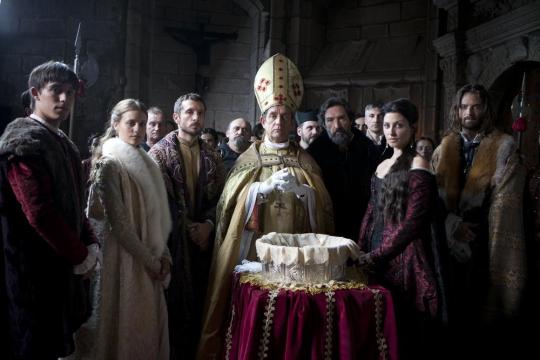
In early 1460s, Castilian nobles became dissatisfied with the rule of Enrique IV, and believed that Princess Juana was not King’s daughter. They called her la Beltraneja, a mocking reference to her supposed illegitimacy. Propaganda and rumour encouraged by the league of rebellious nobles argued that her father was Beltrán de la Cueva, a royal favorite of low background who had been elevated to enormous power by Enrique and who, by some, has been suggested as Enrique's lover.
Many nobles refused to recognise Princess Juana and preferred that Enrique instead name his younger half-brother, Alfonso as his heir. This was agreed to on the condition that Alfonso marries little Juana. Not long after this, Enrique reneged on his promise and began to support his daughter's claim once more. The nobles in league against him conducted a ceremonial deposition-in-effigy of Enrique outside the city of Avila and crowned Alfonso as a rival king.
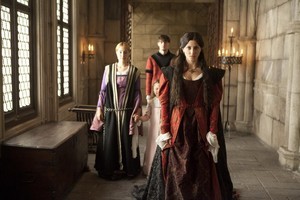
Queen Juana and her daughter were removed from the court. They lived in various castles as hostages, separately or together, protected by a faction of the nobility. The love affair of Queen Juana with the Bishop Fonseca’s nephew, Pedro of Castile, and the birth of her two illegitimate sons, caused great scandal. As a result of the need to conceal the pregnancy of her illegitimate sons, Juana of Portugal is considered the inventor of the farthingale.
In 1468, Alfonso of Castile died and Princess Juana was stripped of her succession-rights. Her aunt, Infanta Isabel, was placed before her, on condition that Isabel marry a man chosen out by the monarch. Queen Juana and her daughter sent a formal appeal to the Supreme Pontiff. Enrique accepted to divorce his wife and send her to Portugal, but Juana remained in Castile as king's wife, though separated of her husband. Isabel married Fernando of Aragon with the opposition of Enrique IV.
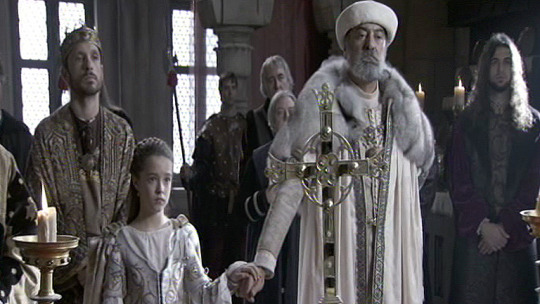
In 1470, Princess Juana was engaged and then married by proxy to the Duke of Guienne, brother of Louis XI of France. In the face of the French ambassador, King Enrique and Queen Juana swore before a crucifix that the Princess was their legitimate daughter. The French marriage never consummated, because the duke died two years later in France. Queen Juana always defended her daughter’s rights to the throne, and she had an active political participation. Queen Juana tried to get the support of nobles and cities, but with meager success and without palpable results. In 1474, Enrique IV died at the Alcázar of Madrid and rumors circulated that the late monarch had been poisoned, his wife and his daughter demanded an investigation. Queen Juana died a few months after her husband’s death at the age of 36. In the last months of her life, she lived at the convent of San Francisco in Madrid. The cause of her death is unknown.
Bárbara Lennie played Juana of Portugal in TV series "Isabel"
#juana de portugal#juana de avis#joan of portugal#women in history#spanish history#barbara lennie#Isabel tve#enrique IV#juana la beltranejs#juana de trastamara#juana de castilla
24 notes
·
View notes
Text







A guide through the monarchs of Aragon in La Catedral del mar & Los Herederos de la tierra
@asongofstarkandtargaryen
During the series the role of the members of the monarchy is secondary, but they are used to help to establish a concrete historical context and they're very determinant in the situation of the Puig and Entanyol families involving political estrategies of supporting this or that king, that gave them benefits or dacay (Arnau's rise with Pedro IV, Genís & Roger rise with Juan I and Martín I and Bernat with Fernando I). So, I wanted to make a recopilation of the monarchs shown during these series and their families.
House of Aragon/ House of Barcelona (descendants of the Jimena dinasty)
The Jimena dinasty is called like that because its origin was Jimeno "the Strong", grandfather of Eneko Arizta, and one of its branches was the Arista-Iñiga dinasty started by Eneko.
Eneko, his son García Iñiguez and his grandson Fortún Garcés were Lords of Pamplona, Fortún Garcés married Awriya bint Lubb ibn Musa (great-grandaughter of Musa the Great), and one of their daughters was Oneka Fortúnez, who married Abd Allah I of Cordoba (their son was Muhammad, who fathered the calipha Abd al-Rahman III with a basque woman called Muzna) and then Oneka married Aznar Sánchez de Larraún, and had a daughter with him, Toda Aznárez. Toda married Sancho Garcés I, the truly first king of Pamplona, was Sancho Garcés I (the first king of the Jimena dinasty).
Sancho Garcés III (992-1036) was king of Pamplona, Count of Aragon and king consort of Castile, whose bastard son with Sancha de Aibar, Ramiro I, inherited the counties of Aragon, Sobarbe and Ribagorza, and united them to form the kingdom of Aragon.
Then Petronila I (1136-1173), Ramiro I's great-grandaughter, married Ramón Berenguer IV count of Barcelona. Their son Alfonso II of Aragon was the first king of the Crown of Aragon and Pedro IV's great-great- great-grandfather.
In summary all the Aragonese monarchs are descedants of Eneko Arizta (and that's the way we can link Irati with LCDM/LHDLT)
Pedro IV
Pedro IV of Aragon, II of Valencia and I of Mallorca (Balaguer, Lleida, Catalonia, September 5, 1319 - Barcelona, Catalonia, January 5, 1387), called "the Ceremonious" or the Punyalet ('the one with the dagger', due to a dagger he used to carry), son of Alfonso IV of Aragon and Teresa de Entenza.
King of Aragon, Valencia and Mallorca (1344-1387); Duke of Athens (1380-1387) and Neopatria (1377-1387); count of Barcelona (1336-1387) and of Ampurias (1386-1387).
In 1338 he married María de Navarra (1326-1347), daughter of Felipe III and Juana II of Navarra. Offspring:
Constanza (1343-1363), married in 1361 to Federico III of Sicily, and Juana (1344-1385), married in 1373 with Juan I de Ampurias.
In 1347 he married Leonor of Portugal (1328-1348), daughter of Alfonso IV of Portugal. She died the following year of the Black Death.
In 1349 he married Eleanor of Sicily (1325-1375), daughter of Pedro II of Sicily. Offspring:
Juan I (1350-1396), Martin I (1356-1410) and Leonor (1358-1382), married to Juan I of Castile. Leonor was the mother of Fernando I of Aragon.
In 1377 he married Sibila de Fortiá, daughter of the Empordà nobleman Berenguer de Fortiá. Offspring:
Isabel (1380–1424), who married Jaime II of Urgel, future suitor for the aragonese crown.
During his reign the Aragonese expansionism in the Mediterranean continued, focused on southern Italy and Greece.
Although he was ally of Alfonso XI, Pedro IV had a great rivalry with his son Pedro I of Castile and fought against him in some conflicts, like the War of the two Pedros (1356-1369) and the first Castilian Civil War (1351-1369), in which Pedro I was supported by Pedro I of Portugal (one of his bastard sons, Juan I of Portugal, was the founder and first king of the Avis dinasty) and Muhammad V of Granada, and Pedro IV supported the bastard children of Alfonso XI with his lover Leonor de Guzmán (Pedro de Aguilar, Sancho Alfonso, Fadrique Alfonso, Enrique II of Castile, Fernando Alfonso, Tello, Juan Alfonso, Juana Alfonso, Sancho and Pedro Alfonso), who started several revolts against Pedro I of Castile. The wars ended when Enrique killed Pedro I, and he became the first king of Castile of the Trastamara dinasty.
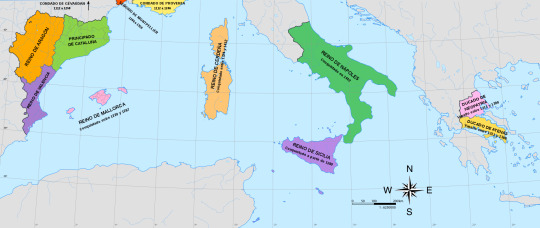
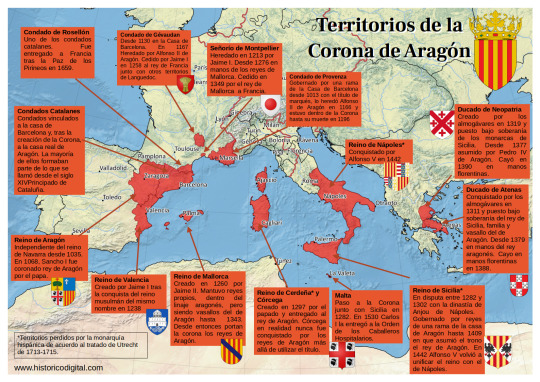
Sibila de Fortiá
Sibila de Fortiá (Fortiá, Girona, Catalonia, 1350 - Barcelona, Catalonia, 1406), queen consort of the Crown of Aragon (1377-1387). She was the daughter of Berenguer de Fortiá and his wife Francesca de Vilamarí. In 1371 she married for the first time Artal de Foces, an Aragonese nobleman, whom she widowed in 1374, and then she the lover of Pedro IV and had a daughter with him, Isabel.Pedro and Sibila married in 1377. After the wedding, Pedro surrounded himself with Empordà nobles as well as Sibila's relatives.
Pedro IV was very ill at the end of the year 1386, and Sibila, fearful of the wrath of the future King Juan, fled to the castle of San Martín de Sarroca (Barcelona), which belonged to her brother Bernat de Fortiá. There she was imprisoned by Juan I, who treated her harshly, accusing her of abandoning the king on his deathbed and of several robberies in the palace. She was confined in the castle of Moncada (Barcelona) until she renounced his property granted by the king. Finally, Sibila retired to the convent of San Francisco in Barcelona, where she died in 1406.
Juan I
Juan I of Aragon, called the Hunter or the Lover of All Kindness (Perpignan, Occitania, France, 1350 - Torroella de Montgrí, Girona, Catalonia, 1396), King of Aragon, Valencia, Mallorca, Sardinia and Corsica, and Count of Barcelona, Roussillon and Cerdanya ( 1387-1396). Son of Pedro IV and Leonor of Sicily.
His first marriage was with Marta de Armagnac (1347-1378), daughter of Count Juan I de Armagnac. With whom he had: Jaime (1374), Juana, (1375-1407) who married Mateo, Count of Foix. After the death of her father, she claimed the throne with her husband, but they were defeated; Juan (1376), Alfonso (1377) and Leonor (1378).
Widowed, Juan married Violante de Bar (1365-1431), daughter of Robert I, Duke of Bar. Offspring:
Jaime Duke of Girona (1382-1388), Yolanda, who married Louis II of Anjou, titular king of Naples. Their son, Luis III, claimed the throne after the death of Martín I, in the engagement of Caspe; Fernando Duke of Girona (1389), Antonia (1391-1392), Juan Duke of Girona (1392-1396), Eleanor (1393), Pedro Duke of Girona (1394) and Juan (1396)
Martin I
Martin I of Aragon, also called the Human or the Old (Girona, July 29, 1356-Barcelona, May 31, 1410), was king of Aragon, of Valencia, of Majorca, of Sardinia and count of Barcelona (1396-1420) and king of Sicily (1409-1410). Second son of Pedro IV of Aragon and his third wife Leonor of Sicily.
Martín was called "the Human" because of his great passion for the Humanities and books. The library of Martín I is the first that could be considered from Renaissance, if at that time in the history of the Iberian peninsula the term can already be used.
Martin married in 1372 with Maria de Luna, daughter of Lope, the first count of Luna, in 1374. From this union they were born:
Jaime (1378), Juan (1380) and Margarita (1388) and Martin I of Sicily "the Younger" (1376-1409), first husband of Blanca I of Navarra.
When Martin the Younger died, Martin married Margarita de Frades, although they left no issue.
His entire reign was marked by the Western Schism that divided Christianity since 1378. He was a supporter of the popes of Avignon (where he went the year of his coronation to swear allegiance to Benedict XIII "the Pope Luna", Pedro Martínez de Luna y Pérez de Gotor, with whom it seems that he came to establish a friendly relationship ), from whom he obtained support in his claims over the kingdom of Sicily against the Anjou, supporters of the popes of Rome. In 1400, he would marry his niece Yolanda to Louis II of Anjou in order to defuse tensions. He met in Avignon with the antipope Benedict XIII, Aragonese and a relative of the queen, with the intention of reaching a solution to the schism and, later, in 1403 he intervened militarily against the siege that Benedict suffered in his papal seat, rescuing him and welcoming him in Peñíscola .
House of Trastamara (the Aragonese branch)
Fernando I
Ferdinand I of Aragon (Medina del Campo, Valladolid, Castile and Leon, November 27, 1380-Igualada, April 2, 1416), also called Fernando de Trastámara and Fernando de Antequera, the Just and the Honest, was an infant of Castile, king of Aragon, Valencia, Mallorca, Sardinia, Count of Barcelona (1412-1416), and regent of Castile (1406-1415), during the minority of Juan II of Castile. Son of Juan I of Castile and Leonor of Aragon.
He was the first Aragonese monarch of the Castilian dynasty of the Trastámara, although he was of Aragonese origin on his mother's side.
He married Leonor de Alburquerque
Alfonso the Magnanimous (Medina del Campo, 1394-1458), king of Aragon, with the name of Alfonso V, and of Naples and Sicily, with the name of Alfonso I.
María de Aragón (Medina del Campo, 1396-1445), first wife of Juan II of Castile and mother of Enrique V of Castile
Juan II (Medina del Campo, 1397-1479), King of Aragon and King consort of Navarre.
Enrique (1400-Calatayud, 1445), II Duke of Villena, III Count of Alburquerque, Count of Ampurias, Grand Master of the Order of Santiago.
Leonor (1402-1445), who married Eduardo I of Portugal. Mother of Alfonso V of Portugal, Juana of Portugal (Enrique IV's second wife) and Leonor of Portugal, who married Frederick III of Habsburg (they were parents of emperor Maximilian I of Austria)
Pedro (1406-1438), IV Count of Alburquerque, Duke of Noto.
Sancho (1400-1416)
Alfonso V
Alfonso V of Aragon (Medina del Campo, 1396 – Naples, June 27, 1458), also called the Wise or the Magnanimous, king of Aragon, of Valencia, of Majorca, of Sicily, of Sardinia and Count of Barcelona (1426-1458); and King of Naples (1446-1458).
Alfonso V can be considered as a genuine prince of the Renaissance, since he developed an important cultural and literary patronage that earned him the nickname of the Wise and that would make Naples the main focus of the entry of Renaissance humanism in the sphere of the Crown of Aragon.
From his relationship with his lover Giraldona de Carlino, a napolitan noblewoman, he had three children:
Fernando (1423-1494), his successor in the kingdom of Naples under the name Fernando I.
Maria (1425-1449), married to Lionel, Marquis of Este and Duke of Ferrara.
Leonor, or Diana Eleonora (?-1450), married the nobleman Marino Marzano, Prince of Rossano.
Maria of Castile
María of Castile (Segovia, Castile and Leon, November 14, 1401-Valencia, October 4, 1458). Infanta of Castile, Princess of Asturias (1402-1405) and Queen of Aragon (1416-1458) for her marriage to Alfonso the Magnanimous. First daughter of Enrique III "the Mourner" and Catherine of Lancaster. Sister of Juan II of Castile, untie of Enrique IV and Isabel I.
The marriage between María and Alfonso is celebrated in the Cathedral of Valencia on October 12, 1415. The ceremony was officiated by the antipope Benedict XIII, who also granted the matrimonial dispensation for the wedding.
In 1420, when the king left for Naples for the first time, he left the government of his kingdoms in the hands of Maria as lieutenant general. The absence of the Magnanimous would last three years, during which María had to face the rapid deterioration of the economic situation in Catalonia, the territorial struggle with the Castilian Crown, as well as the conflicts of a social nature that shook her in different kingdoms. On his return to Aragon in 1423, Alfonso V began the war with Castile, along with his brother King Juan of Navarra. But her financial resources were exhausted and in 1429 Queen María had to act as a mediator between her husband and her brother, King Juan II of Castile, to put an end to the dispute. However, Alfonso's situation did not improve, due to the recession suffered by the Catalan economy and the social conflicts caused by it. The Courts of Barcelona in 1431 demanded from the king a series of measures to correct the enormous deficit of the Catalan treasury and trade. But Alfonso, fed up with these matters, returned to Italy and gave full powers to the queen as ruler of Aragon; he left the Iberian Peninsula forever on May 29, 1432. This marked Alfonso V's final break with the Crown of Aragon, which, however, he never renounced.
+ Bonus track (although he doesn't appear in this series)
Juan II
Juan II of Aragon and Navarra, the Great, or the Faithless according to the Catalan rebels who rose up against him (Medina del Campo, June 29, 1398-Barcelona, January 20, 1479) was Duke of Peñafiel, King of Navarre (1425-1479), King of Sicily (1458-1468) and King of Aragon, Mallorca, Valencia, Sardinia (1458-1479) and Count of Barcelona, son of Ferdinand I of Aragon and Leonor de Albuquerque.
From his first marriage to Blanca I of Navarra (daughter of Leonor of Castile and Carlos III of Navarra):
Carlos (1421-1461), Prince of Viana and Girona, Duke of Gandia and Montblanch, titular King of Navarra as Carlos IV (1441–1461), married Agnes of Cleves. He wrote the 'Chronicles of the Monarchs of Navarra', about the history of his antecessors, from Eneko Arizta in the 8th century up to the 15th century.
Juan (1423-1425)
Blanca of Navarra (1424-1464), first wife of Enrique IV of Castile
Leonor (1425-1479), married to Gastón IV de Foix, Queen of Navarre under the name of Leonor I.
From his second marriage to Juana Enríquez:
Leonor of Aragon (1448)
Fernando II (1452-1516), king iure uxoris of Castile (1474-1504) and then regent between 1507 and 1516, under the name of Fernando V due to his marriage to Isabel I, king of Sicily (as Fernando II, 1468-1516), Aragon and Sardinia (as Fernando II, 1479-1516), Naples (as Fernando III, 1504-1516), and from Navarra (as Fernando I, 1512-1516)
Juana (1455-1517), second wife of Fernando I of Naples. Her daughter Juana married Fernando II of Naples (Fernando I of Naples' grandson)
During his youth, Juan fought in the Castilian-Aragonese war (1429-30) and the Castilian Civil War (1437-1445) in the Aragonese team against Juan II of Castile, his son Enrique and the Constable Álvaro de Luna (favourite of Juan II), due to the Aragonese political influences in Castile and the full control that Álvaro de Luna had over Juan II of Castile that allowed him to become very powerful, so some members of the Castilian nobility wanted to remove Álvaro out of Juan II side because of that, and the Aragonese reacted to the anti-aragonese convictons of Álvaro.
Álvaro de Luna arranged a new marriage between Juan II of Castile and Isabel of Portugal (mother of Isabel I) in 1447. The constable intended with this dynastic alliance to strengthen the political ties that united Castile and Portugal against the common enemy: the Catalan-Aragonese Crown, but from 1449, Isabella of Portugal indirectly supported the maneuvers of the Great League of Nobles (allies of the Aragonese) formed against the constable. But it would not be until 1453 when Juan II of Castile, possibly tired of the continuous pressure from the aristocracy, left Álvaro on his own. It has often been said that it was the queen herself who demanded that her husband signed the prison order against Álvaro, through Juan Pacheco, Marquis of Villena.
By 1441 Blanca I de Navarra died and Juan II married the daughter of Fadrique Enríquez (one of his Castilian allies, the admiral of Castile), Juana Enríquez y Fernández de Córdoba.
After the death of Blanca I, a dispute between Juan II and Carlos de Viana about the sucession for the Navarrese throne. Juan was king Iure uxoris of Navarre and wanted to be keep his position as king, but Carlos and his supporters claimed that the prince was the rightful king as firstborn son of the queen and in 1451 the Navarrese civil war started.
In the following years the tension between Juan and Carlos increased with the birth of Fernando, who was pushed by his mother Juana to be the heir of Aragon and Navarra, which Juan later accepted. This change in the sucession was not accepted in Catalonia, that supported Carlos de Viana birthrights, and they started a rebellion against Juan II.
Other supporter of Carlos was Enrique IV, who offered his sister Isabel to Carlos in marriage as a sign of their alliance, but the wedding never happened.
Carlos died in 1461, although the war didn't ended because the Catalan nobility proposed other suitors for the Crown of Aragon and the Principality of Catalonia, like Enrique IV, Pedro of Portugal (grandson of Jaime II of Urgell) and Renato de Anjou during the Catalan civil war, that ended in 1472.
It's interesting that the interesting that the current situation of the Estanyol family at the end of Los Herederos de la tierra is that there are two brothers from different mothers, and whose father have benefited one of them over the other, so it may lead to tensions from the part that was not benefited, Arnau Jr is the main heir in Bernat's will, so maybe in the future Marta Destorrent will try to pit her son Baltasar against his elder brother to take Arnau Jr's place. By period of time I find very likely that this happens during the reigns Maria of Castile and Juan II, and the situation of the Estanyol succession could parallel the Carlos de Viana-Fernando II problem, although in this case the younger son was the benefited one and the one who inherited his father's kingdoms and maybe the Estanyols are part of the Catalan nobility that defended Carlos' birthrights, although some other Catalan nobles supported Juan II & Fernando alongside of peasants and smallfolk, during the First Remensa War during the Catalan civil war.
The Remensa War consisted in revolts organised by peasants who wanted to end the servitude to which their feudal lords had subjected them, so I think that probably the Estanyol-Llor family would support the peasants because of their backgrounds.
#la catedral del mar#los herederos de la tierra#the cathedral of the sea#heirs to the land#history#crown of aragon#aragonese monarchs#pedro iv de aragón#juan i de aragón#martín i de aragón#sibila de fortiá#fernando i de aragón#alfonso v de aragón#maria de castilla#juan ii de aragón#gifs#period dramas#house of aragon#house of trastamara#house of barcelona#long post
21 notes
·
View notes
Text
Preliminary List of Monarchs:
Rudolph, First Archduke of Austria
Fredrick III, Holy Roman Emperor, Archduke of Austria, etc.
Maximilian I, Holy Roman Emperor, Archduke of Austria, etc.
Ferdinand I, Holy Roman Emperor, Archduke of Austria, etc.
Maximilian II, Holy Roman Emperor, Archduke of Austria, etc.
Maximilian III, Archduke of Austria, Disputed King of Poland
Rudolph II, Holy Roman Emperor, King of the Germans, Archduke of Austria, etc.
Matthias, Holy Roman Emperor, Archduke of Austria, etc.
Ferdinand II, Holy Roman Emperor, Archduke of Austria, etc.
Ferdinand III, Holy Roman Emperor, Archduke of Austria, etc.
Leopold I, Holy Roman Emperor, Archduke of Austria, etc.
Joseph I, Holy Roman Emperor, Archduke of Austria, etc.
Philip I, The Handsome, King of Castile
Charles I (V), Holy Roman Emperor, Archduke of Austria, King of Spain, etc.
Philip II, King of Spain, King of Portugal, King of Naples and Sicily
Philip III, King of Spain, King of Portugal, Naples, Sicily, etc.
Philip IV, King of Spain, King of Portugal
Charles II, King of Spain
Margret of Austria, Duchess of Savoy, Governor of the Netherlands
Mary of Hungary, Queen of Hungary and Bohemia, Governor of the Netherlands
Charles VI, Holy Roman Emperor, Archduke of Austria, Disputed King of Spain
Maria Theresa, Archduchess of Austria, King of Hungary, etc.
Joseph II, Holy Roman Emperor, Archduke of Austria, etc.
Leopold II, Holy Roman Emperor, Archduke of Austria, etc.
Franz II/I, Holy Roman Emperor, Austrian Emperor, Archduke of Austria, etc.
Ferdinand I, Emperor of Austria, King of Hungary, etc.
Franz Joseph, Emperor of Austria, King of Hungary, etc.
Maximilian of Mexico
Charles I, Emperor of Austria, King of Hungary
Maria Leopoldina, Empress of Brazil
Pedro II, Emperor of Brazil
Napoleon II, King of Rome, Duke of Reichstadt
Marie Luisa, Duchess of Parma, Empress of the French
Ferdinand III, Grand Duke of Tuscany
Leopold II, Grand Duke of Tuscany
Ferdinand IV, Grand Duke of Tuscany
Feel free to tell me who you think we are missing or to start sending in propaganda for your favorite. It will be included in the poll.
#there are some you could argue with here#and technically I have too many to make a tidy bracket#but hmmmm who to drop#also yes I did add more women so Maria Theresa wouldn't be the only one
5 notes
·
View notes
Text
Events 1.1
153 BC – For the first time, Roman consuls begin their year in office on January 1.
45 BC – The Julian calendar takes effect as the civil calendar of the Roman Empire, establishing January 1 as the new date of the new year.
42 BC – The Roman Senate posthumously deifies Julius Caesar.
193 – The Senate chooses Pertinax against his will to succeed Commodus as Roman emperor.
404 – Saint Telemachus tries to stop a gladiatorial fight in a Roman amphitheatre, and is stoned to death by the crowd. This act impresses the Christian Emperor Honorius, who issues a historic ban on gladiatorial fights.
417 – Emperor Honorius forces Galla Placidia into marriage to Constantius, his famous general (magister militum) (probable).
1001 – Grand Prince Stephen I of Hungary is named the first King of Hungary by Pope Sylvester II (probable).
1068 – Romanos IV Diogenes marries Eudokia Makrembolitissa and is crowned Byzantine Emperor.
1259 – Michael VIII Palaiologos is proclaimed co-emperor of the Empire of Nicaea with his ward John IV Laskaris.
1438 – Albert II of Habsburg is crowned King of Hungary.
1500 – Portuguese explorer Pedro Álvares Cabral discovers the coast of Brazil.
1502 – The present-day location of Rio de Janeiro, Brazil, is first explored by the Portuguese.
1515 – Twenty-year-old Francis, Duke of Brittany, succeeds to the French throne following the death of his father-in-law, Louis XII.
1527 – Croatian nobles elect Ferdinand I, Archduke of Austria as King of Croatia in the 1527 election in Cetin.
1600 – Scotland recognises January 1 as the start of the year, instead of March 25.
1604 – The Masque of Indian and China Knights is performed by courtiers of James VI and I at Hampton Court.
1651 – Charles II is crowned King of Scotland at Scone Palace.
1700 – Russia begins using the Anno Domini era instead of the Anno Mundi era of the Byzantine Empire.
1707 – John V is proclaimed King of Portugal and the Algarves in Lisbon.
1739 – Bouvet Island, the world's remotest island, is discovered by French explorer Jean-Baptiste Charles Bouvet de Lozier.
1772 – The first traveler's cheques, which could be used in 90 European cities, are issued by the London Credit Exchange Company.
1773 – The hymn that became known as "Amazing Grace", then titled "1 Chronicles 17:16–17", is first used to accompany a sermon led by John Newton in the town of Olney, Buckinghamshire, England.
1776 – American Revolutionary War: Norfolk, Virginia is burned by combined Royal Navy and Continental Army action.
1776 – General George Washington hoists the first United States flag, the Grand Union Flag, at Prospect Hill.
1781 – American Revolutionary War: One thousand five hundred soldiers of the 6th Pennsylvania Regiment under General Anthony Wayne's command rebel against the Continental Army's winter camp in Morristown, New Jersey in the Pennsylvania Line Mutiny of 1781.
1788 – The first edition of The Times of London, previously The Daily Universal Register, is published.
1801 – The legislative union of Kingdom of Great Britain and Kingdom of Ireland is completed, and the United Kingdom of Great Britain and Ireland is proclaimed.
1801 – Ceres, the largest and first known object in the Asteroid belt, is discovered by Giuseppe Piazzi.
1804 – French rule ends in Haiti. Haiti becomes the first black-majority republic and second independent country in North America after the United States.
1806 – The French Republican Calendar is abolished.
1808 – The United States bans the importation of slaves.
1810 – Major-General Lachlan Macquarie officially becomes Governor of New South Wales.
1822 – The Greek Constitution of 1822 is adopted by the First National Assembly at Epidaurus.
1834 – Most of Germany forms the Zollverein customs union, the first such union between sovereign states.
1847 – The world's first "Mercy" Hospital is founded in Pittsburgh, United States, by a group of Sisters of Mercy from Ireland; the name will go on to grace over 30 major hospitals throughout the world.
1860 – The first Polish stamp is issued, replacing the Russian stamps previously in use.
1861 – Liberal forces supporting Benito Juárez enter Mexico City.
1863 – American Civil War: The Emancipation Proclamation takes effect in Confederate territory.
1877 – Queen Victoria of the United Kingdom is proclaimed Empress of India.
1885 – Twenty-five nations adopt Sandford Fleming's proposal for standard time (and also, time zones).
1890 – Eritrea is consolidated into a colony by the Italian government.
1892 – Ellis Island begins processing immigrants into the United States.
1898 – New York, New York annexes land from surrounding counties, creating the City of Greater New York. The four initial boroughs, Manhattan, Brooklyn, Queens, and The Bronx, are joined on January 25 by Staten Island to create the modern city of five boroughs.
1899 – Spanish rule ends in Cuba.
1900 – Nigeria becomes British protectorate with Frederick Lugard as high commissioner.
1901 – The Southern Nigeria Protectorate is established within the British Empire.
1901 – The British colonies of New South Wales, Queensland, Victoria, South Australia, Tasmania, and Western Australia federate as the Commonwealth of Australia; Edmund Barton is appointed the first Prime Minister.
1902 – The first American college football bowl game, the Rose Bowl between Michigan and Stanford, is held in Pasadena, California.
1910 – Captain David Beatty is promoted to Rear admiral, and becomes the youngest admiral in the Royal Navy (except for Royal family members) since Horatio Nelson.
1912 – The Republic of China is established.
1914 – The SPT Airboat Line becomes the world's first scheduled airline to use a winged aircraft.
1923 – Britain's Railways are grouped into the Big Four: LNER, GWR, SR, and LMS.
1927 – New Mexican oil legislation goes into effect, leading to the formal outbreak of the Cristero War.
1928 – Boris Bazhanov defects through Iran. He is the only assistant of Joseph Stalin's secretariat to have defected from the Eastern Bloc.
1929 – The former municipalities of Point Grey, British Columbia and South Vancouver, British Columbia are amalgamated into Vancouver.
1932 – The United States Post Office Department issues a set of 12 stamps commemorating the 200th anniversary of George Washington's birth.
1934 – Alcatraz Island in San Francisco Bay becomes a United States federal prison.
1934 – A "Law for the Prevention of Genetically Diseased Offspring" comes into effect in Nazi Germany.
1942 – The Declaration by United Nations is signed by twenty-six nations.
1945 – World War II: The German Luftwaffe launches Operation Bodenplatte, a massive, but failed, attempt to knock out Allied air power in northern Europe in a single blow.
1947 – Cold War: The American and British occupation zones in Allied-occupied Germany, after World War II, merge to form the Bizone, which later (with the French zone) became part of West Germany.
1947 – The Canadian Citizenship Act 1946 comes into effect, converting British subjects into Canadian citizens. Prime Minister William Lyon Mackenzie King becomes the first Canadian citizen.
1948 – The British railway network is nationalized to form British Railways
1949 – United Nations cease-fire takes effect in Kashmir from one minute before midnight. War between India and Pakistan stops accordingly.
1956 – Sudan achieves independence from Egypt and the United Kingdom.
1957 – George Town, Penang, is made a city by a royal charter of Queen Elizabeth II of the United Kingdom.
1957 – Lèse majesté in Thailand is strengthened to include "insult" and changed to a crime against national security, after the Thai criminal code of 1956 went into effect.
1958 – The European Economic Community is established.
1959 – Cuban Revolution: Fulgencio Batista, dictator of Cuba, is overthrown by Fidel Castro's forces.
1960 – Cameroon achieves independence from France and the United Kingdom.
1962 – Western Samoa achieves independence from New Zealand; its name is changed to the Independent State of Western Samoa.
1964 – The Federation of Rhodesia and Nyasaland is divided into the independent republics of Zambia and Malawi, and the British-controlled Rhodesia.
1965 – The People's Democratic Party of Afghanistan is founded in Kabul, Afghanistan.
1970 – The defined beginning of Unix time, at 00:00:00.
1971 – Cigarette advertisements are banned on American television.
1973 – Denmark, Ireland and the United Kingdom are admitted into the European Economic Community.
1976 – A bomb explodes on board Middle East Airlines Flight 438 over Qaisumah, Saudi Arabia, killing all 81 people on board.
1978 – Air India Flight 855, a Boeing 747, crashes into the Arabian Sea off the coast of Bombay, India, due to instrument failure, spatial disorientation, and pilot error, killing all 213 people on board.
1979 – Normal diplomatic relations are established between the People's Republic of China and the United States.
1981 – Greece is admitted into the European Community.
1982 – Peruvian Javier Pérez de Cuéllar becomes the first Latin American to hold the title of Secretary-General of the United Nations.
1983 – The ARPANET officially changes to using TCP/IP, the Internet Protocol, effectively creating the Internet.
1984 – The original American Telephone & Telegraph Company is divested of its 22 Bell System companies as a result of the settlement of the 1974 United States Department of Justice antitrust suit against AT&T.
1984 – Brunei becomes independent of the United Kingdom.
1985 – The first British mobile phone call is made by Michael Harrison to his father Sir Ernest Harrison, chairman of Vodafone.
1987 – The Isleta Pueblo tribe elect Verna Williamson to be their first female governor.
1988 – The Evangelical Lutheran Church in America comes into existence, creating the largest Lutheran denomination in the United States.
1989 – The Montreal Protocol comes into force, stopping the use of chemicals contributing to ozone depletion.
1990 – David Dinkins is sworn in as New York City's first black mayor.
1993 – Dissolution of Czechoslovakia: Czechoslovakia is divided into the Czech Republic and Slovak Republic.
1994 – The Zapatista Army of National Liberation initiates twelve days of armed conflict in the Mexican state of Chiapas.
1994 – The North American Free Trade Agreement (NAFTA) comes into effect.
1995 – The World Trade Organization comes into being.
1995 – The Draupner wave in the North Sea in Norway is detected, confirming the existence of freak waves.
1995 – Austria, Finland and Sweden join the EU.
1998 – Following a currency reform, Russia begins to circulate new rubles to stem inflation and promote confidence.
1998 – Argentinian physicist Juan Maldacena published a landmark paper initiating the study of AdS/CFT correspondence, which links string theory and quantum gravity.
1999 – Euro currency is introduced in 11 member nations of the European Union (with the exception of the United Kingdom, Denmark, Greece and Sweden; Greece adopts the euro two years later).
2004 – In a vote of confidence, General Pervez Musharraf wins 658 out of 1,170 votes in the Electoral College of Pakistan, and according to Article 41(8) of the Constitution of Pakistan, is "deemed to be elected" to the office of President until October 2007.
2007 – Bulgaria and Romania join the EU.
2007 – Adam Air Flight 574 breaks apart in mid-air and crashes near the Makassar Strait, Indonesia, killing all 102 people on board.
2009 – Sixty-six people die in a nightclub fire in Bangkok, Thailand.
2010 – A suicide car bomber detonates at a volleyball tournament in Lakki Marwat, Pakistan, killing 105 and injuring 100 more.
2011 – A bomb explodes as Coptic Christians in Alexandria, Egypt, leave a new year service, killing 23 people.
2011 – Estonia officially adopts the Euro currency and becomes the 17th Eurozone country.
2013 – At least 60 people are killed and 200 injured in a stampede after celebrations at Félix Houphouët-Boigny Stadium in Abidjan, Ivory Coast.
2015 – The Eurasian Economic Union comes into effect, creating a political and economic union between Russia, Belarus, Armenia, Kazakhstan and Kyrgyzstan.
2017 – An attack on a nightclub in Istanbul, Turkey, during New Year's celebrations, kills at least 39 people and injures more than 60 others.
2 notes
·
View notes
Text
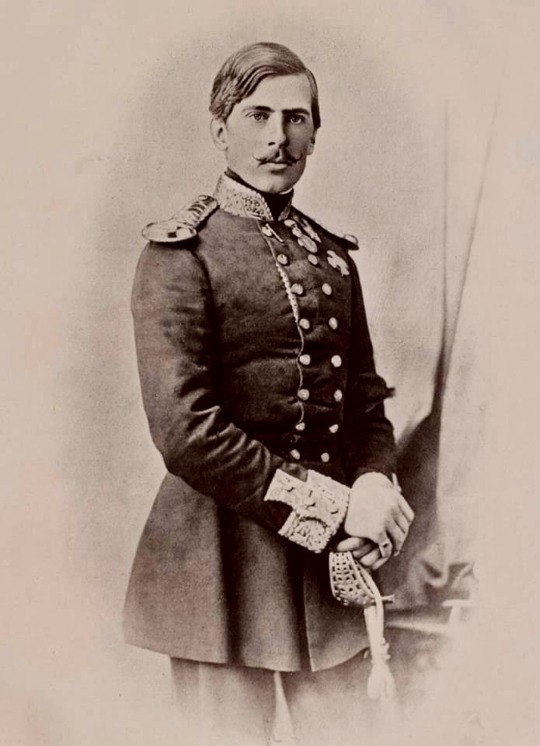
“Peter V (Portuguese: Pedro V - 16 September 1837 – 11 November 1861), nicknamed "the Hopeful" (Portuguese: o Esperançoso), was King of Portugal from 1853 to 1861.”
From X
0 notes
Text
Porto - Day 3
Tuesday - 10/10
Our hotel is located at Batalha Square (Praca da Batalha). The square is named after a 10th-century battle fought between the Moors and the inhabitants of Porto, which resulted in the defeat of the inhabitants. The picture on the left shows a statue of King Pedro V in the square with our hotel in the left background. A tram used to run through this square in front of our hotel (picture on the right), but that tram line has been temporarily replaced by a bus route due to construction going on in other parts of the city.
Until the tram service is resumed, I am not sure I would stay at this hotel again. The hotel is located on the edge of the Porto main area on top of a hill, so every time you want to go somewhere you have to walk up and down hills. While it’s hard to avoid hills in Porto, I would choose a location that is more centrally located. I would consider checking out Porto bay Flores, which is recommended by Conde Nest Traveler and centrally located in Porto.
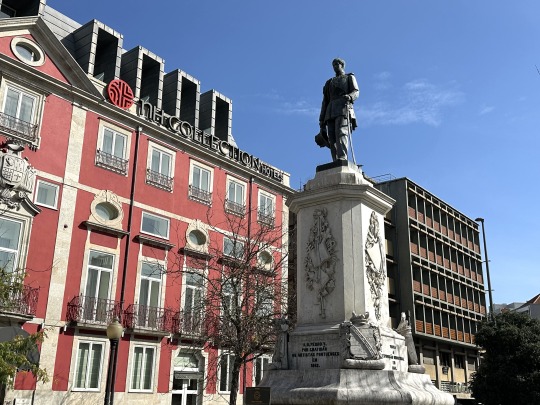

Our first stop today was to go to Porto Cathedral (Catedral do Porto). The cathedral was built in the 12th century. Note the blue tile on the right.


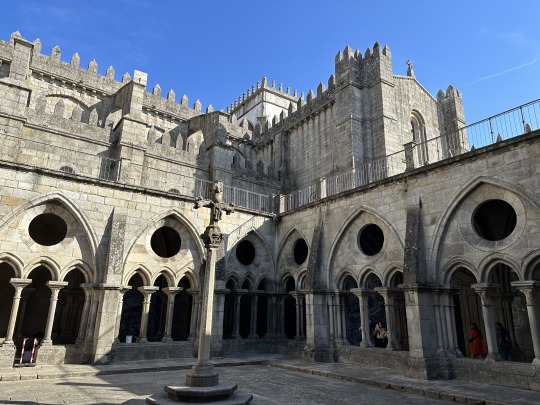

Next we bought food for a picnic lunch and started a walk. As we walked through the city we have seen a lot of street artists/performers in Porto.


We ultimately walked along the river for about 30 minutes and had lunch along the way. After lunch we went to the Tram Museum (Museu Carro Electrico). Porto first had horse drawn trams (picture on the left below), then steam trams and finally electric trams. Early electric trams had a catcher in the front to scoop up any people or animals in their way so the didn’t run over them (picture on the right below).


The pictures below show some of the specialized tram cars. The tram on the left moved baskets of fish within Porto and the tram on the right was used to transport coal.

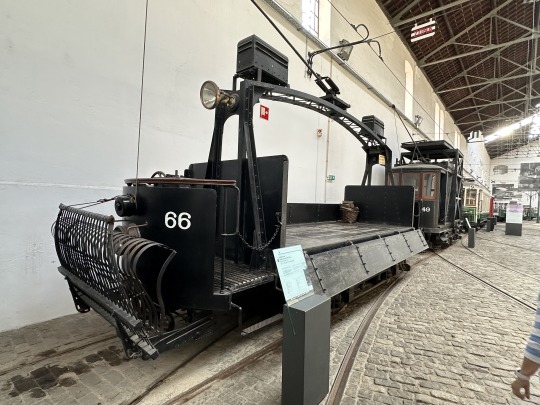
After the Tram Museum we took our first bus ride in Porto. Bus route 500 goes along the river back to the center of the city. Once there we went to Saint Francis Church (Igreja de Sao Francisco), which is Port’s only Gothic style church.
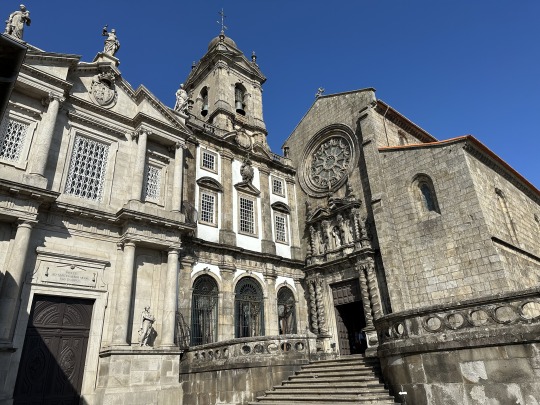

They didn’t allow any photos inside; the picture below is from the internet.

Next stop was the Stock Exchange Palace (Palácio da Bolsa). This was where the Portugal stock exchange was first located and now houses the Commercial Association of Porto. Taking a guided tour of the palace is very popular and we waited in a line for about 30 minutes earlier in the day to get tickets for a 5pm English speaking tour.

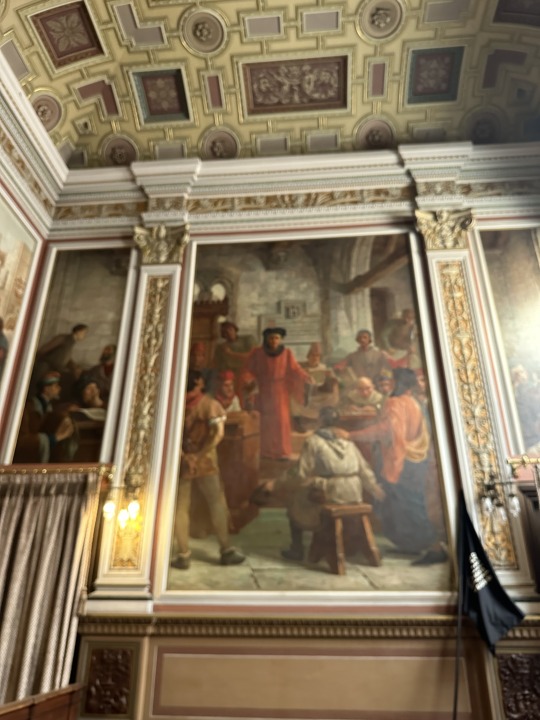

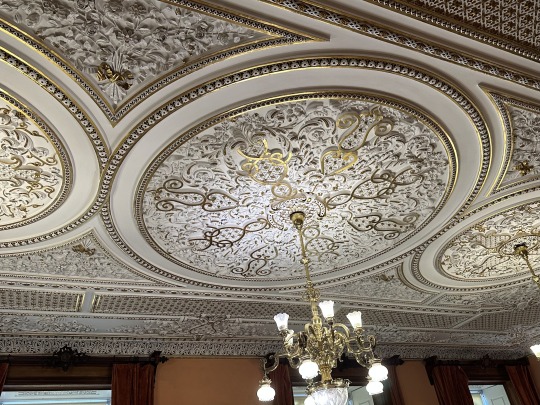

Below is Arabian Hall, which was inspired by Granada’s Alhambra and decorated in th Moorish style with wood, plaster and gold leaf. It took 18 years to build.

Afterwards we had dinner in the Majestic Cafe, a historical and luxurious coffeehouse/restaurant known for it architectural beauty that dates back to the 1920s.

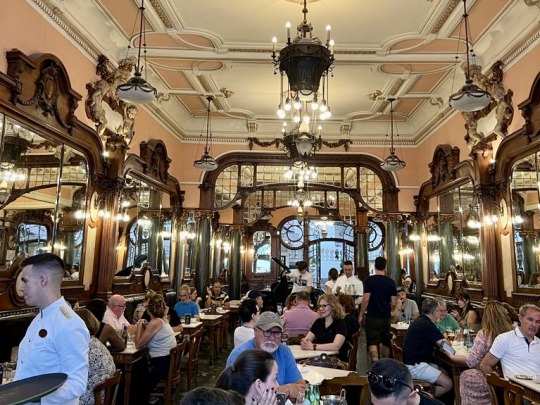
We shared a Francesinha and a club house sandwich. A Francesinha is a Portuguese sandwich, which originated in Porto, made with layers of toasted bread, steak, spiced sausage and ham, over which sliced cheese is melted and then covered with a warm tomato-and-beer sauce. It looks like a prescription for a heart attack, but tasted good.

After dinner we went window shopping on Rua de Santa Catarina.
0 notes
Text
Empress Leopoldina and her grandson King Pedro V of Portugal


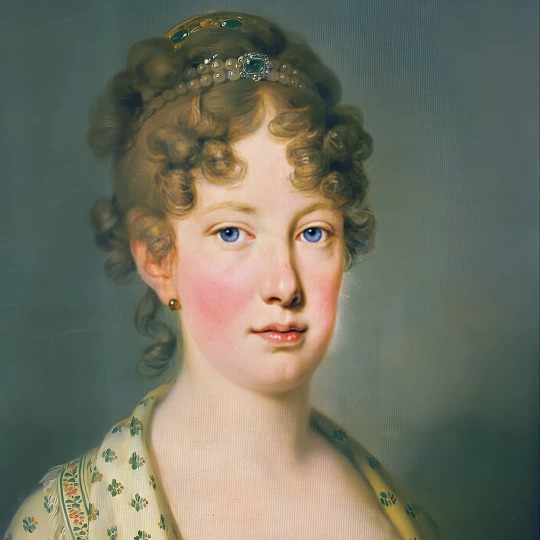
20 notes
·
View notes
Photo

Pedro V, by W. Corden,
Palácio Nacional da Ajuda
#king of portugal#portugal#painting#beuaty in art#classical art#portrait#pedro v#monarchy#beauty in monarchy#royalism#young men
103 notes
·
View notes
Text
The Funeral of Catherine of Braganza, Queen Consort of England
The Funeral of Catherine of Braganza, Queen Consort of England
St. Mary’s Church and the Jerónimo Monastery of Belem in Lisbon (Photo credit: Jean-Pierre Dalbéra from Paris, France on Wikipedia Commons)
Catherine of Braganza was married to King Charles II of England for twenty-three years. As a bride of twenty-three, she left her sheltered existence in Portugal and sailed to England in 1662. Catherine was sincerely in love with her husband but it wasn’t an…

View On WordPress
#Braganza monarchy#Braganza pantheon#Catherine of Braganza#Charles II#Church of St. Mary#Convent of St. Vincente de Fora#early modern history#James II#Jeronimos Monastery#King of England#King of Portugal#Mary of Modena#Palace of Bemposta#Pedro II#Pedro V#Popish Plot#Portuguese History#Queen of England#Stuart monarchy#Vasco da Gama#William and Mary
6 notes
·
View notes
Photo

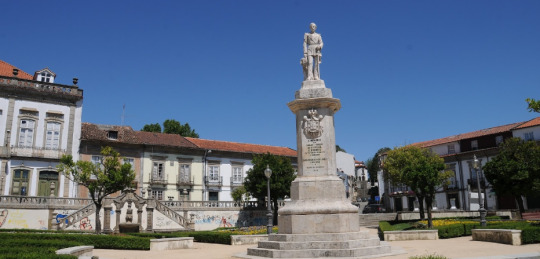
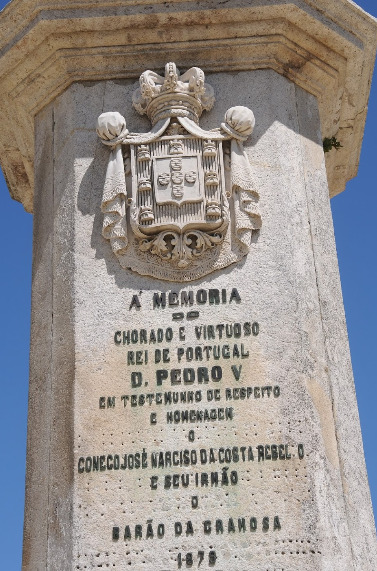
Estátua a D. Pedro V e armas régias portuguesas, campo das hortas, Braga, Portugal.
1 note
·
View note
Text
Our Contestants
1: Maria Leopoldina of Austria, First Empress of Brazil
2 Dona Maria I of Portugal
3: Dona Maria II of Portugal
4: Isabel, Princess Imperial of Brazil
5 Carlota Joaquina de Bourbon
6: João I, Duke of Bragança
7 João IV, King of Portugal
8: Afonso I, Duke of Bragança
9: Fernando I, Duke of Bragança
10: Jaime I, Duke of Bragança
11: Teodósio I, Duke of Bragança
12: Teodósio II, Duke of Bragança
13: Afonso VI of Portugal
14 Pedro II of Portugal
15: João V of Portugal
16: João VI of Portugal
17: Pedro II of Portual
18 Pedro I of Brazil/ IV of Portugal
19: Miguel I of Portugal
20: Pedro V of Portugal
21: Luís I of Portugal
22: Carlos I of Portugal
23: Manuel II of Portugal
24 Dom Pedro II of Brazil
25: Teresa Cristina, Empress of Brazil.
26: Catherine de Bragança, Queen Consort of England, Scotland, and Ireland
27: Infante Dom Manuel, Candidate for the throne of Poland
28: José I of Portugal
29: Carol II of Romania (Carlos II in Portuguese)
30: Ferdinand I of Romania
31: Infantá Antonia de Bragança, Princess Consort of Hohenzollern
32: Amélie of Leuchtenberg
33: Infanta Isabel Maria, Regent of Portugal
34: Mariana Vitória of Spain, Queen Consort of Portugal
35: Maria Francisca of Savoy (Consort to Afonso VI and Pedro II)
36: Maria Pia of Savoy (Queen-Consort to Luís I of Portugal)
6 notes
·
View notes
Text
Portugal-Spain: Nine centuries of summits
[Translation of the sidebar historical timeline from this article. Article translation here]
__
History shows that there is nothing more untrue than the proverb “no good wind or wedding comes from Spain”: the tiffs simply prove that the Portuguese and Spanish share a lot more than the Iberian Peninsula’s soil.
Written by Rosa Ferreira
1096 – Alfonso VI, “Emperor of all Spain”, gives his daughter Teresa’s hand in marriage to Henry of Burgundy, and the County of Portucale along with it.
1143 – In the summit (“Conference”) of Zamora, Alfonso VII of Leon and Castile recognises his cousin Afonso Henriques as the king of an independent Portugal.
1297 – Through the Treaty of Alcanizes, Castile recognises Portugal’s borders, unchanged until today, with the exception of Olivença: they are the oldest in Europe.
1340 – Summit between Afonso IV of Portugal and Alfonso XI of Castile allows the formation (with Aragon) of an ample, shared Christian front which defeats the last Islamic offensive in the Iberian Peninsula in the battle of Salado.
1345-1355 – After the death of his wife, Pedro, the prince heir of Portugal, enters into a “de facto union” with the Galician Inês de Castro, daughter of a nobleman involved in the dynastic disputes of Castile. To avoid Portugal’s involvement in the conflict, Afonso IV condemns Inês to death. After the death of his father, Pedro I of Portugal makes an agreement with Pedro of Castile to obtain the extradition of the murderers, who had taken refuge in that kingdom, and avenges his beloved with nuances of wickedness. Coincidence: two kings called Pedro reigned in Portugal and Castile, and both became known to history as “the Cruel”.
1383 – The Treaty of Salvaterra de Magos: after three consecutive defeats, Fernando of Portugal gives up his rights to the Castilian crown and weds his daughter Beatriz to Juan I of Castile. The revolution of Lisbon and the war for independence follow, which culminate with Portuguese victory in Aljubarrota.
1494 – The Treaty of Tordesillas splits the undiscovered world between Portugal and Castile, with the agreement of Pope Alexander VI.
1498 – Manuel I and his wife Isabel (Prince Afonso’s widow) are recognised in the courts of Toledo as heirs to the crown of Castile. But Aragon’s courts refuse to accept the succession: the throne must go to a masculine heir. Everything seems to be solved with the birth of Miguel da Paz, son of the monarchs of Portugal. While his mother dies during labour, Miguel inherits both empires... but his death before he turns two “delivers” the Spanish crown to the future Emperor Charles V.
1576 - Meeting in Guadalupe. In this summit, Sebastian proposes to his cousin* Phillip II a joint attack against Morocco’s moors. Phillip refuses and tries to dissuade him from his African adventure. Faced with his cousin's stubbornness, he ends up helping him: many Spaniards died next to the Portuguese in the battle of Ksar el-Kebir (1578).
1580 – The Tomar courts acclaim Phillip II of Spain as Phillip I of Portugal. The new king promises to keep Portuguese laws and the autonomy of the Kingdom and Empire's administration, and pledges to only nominate Portuguese people for its government. He pays the ransom of most of the Portuguese nobles held captive in Morocco after the defeat of Ksar el-Kebir.
1640 – In response to the centralized politics of the Count-Duke of Olivares (Gaspar de Guzmán), prime minister of Phillip IV (III of Portugal), who wants to impose Castile's hegemony, a group of Portuguese nobles restores independence. The crown is given to the duke of Braganza, João IV. The attitude of his wife, the Spanish Luísa de Gusmão, served to end the duke's hesitations: “I'd rather die ruling than live serving”, she is reputed to have said.
1668 – Having lost the war, Spain recognizes, through the Treaty of Madrid, the independence of Portugal.
1706 – The Portuguese Army, commanded by the marquis of Minas, arrives triumphant in Madrid during the war of Spanish succession, and acclaims as king the candidate supported by Portugal, archduke Charles of Austria. Less than a year later, the Portuguese leave the battle of Almansa defeated, and the Spanish crown goes to the grandson of Louis XIV of France, Phillip V, who initiates the Bourbon dynasty.
1801 - “War of the Oranges”. The Spain of Carlos IV, backed by Napoleon's France, attacks Portugal, England's ally, and conquers Olivença. Despite the military and diplomatic turnarounds, with special attention to the Congress of Vienna in 1815, which recognized Portugal's sovereignty over the territory, Spain did not return Olivença.
1807 – Invasion of Portugal by a French army to which Spain allowed passage. The Portuguese royal family flee to Brazil. There, the Spanish princess Carlota Joaquina, wife of João VI, tries unsuccessfully to become queen of the Spanish colonies of South America.
1820 – Liberal revolutions in Spain and Portugal. The next year, king João VI, Carlota Joaquina and prince Miguel return to Lisbon, and in 1822 the first Portuguese Constitution is approved, very much inspired by the 1812 Spanish one.
1823 – Counterrevolution in Portugal (Vilafrancada) and in Spain (French intervention brings down the liberal government.) The constitutional regime is suspended and absolutism returns to both countries' monarchies.
1834 – Former king Pedro IV of Portugal and former emperor of Brazil wins the civil war for the liberals and leaves the throne to his daughter, Maria II, as constitutional Queen. The campaigns of the “freedom army” were financed by the Spanish merchant Juan de Mendizábal.
1847 – Spanish army intervention in Portugal, by request of the Portuguese chartist government, to dominate the Patuleia revolt (which followed the Maria da Fonte revolt).
1868 – In the sequence of the revolution that expelled from Madrid the Queen Isabel II, the new power offers the Spanish crown to Fernando II of Portugal (widower of Maria II and father of king Luís I). Prudent and well warned, the “artist king” refuses.
1908 – 1916 – Alfonso XIII of Spain, who held the dream of Iberian hegemony since the regicide, acts towards an intervention regarding the instability of the Portuguese Republic proclaimed in 1910. But he doesn't dare act when faced with British intransigence, which considers any interference inadmissible. Portugal's entry in WWI on the Allied side ends any pretension of such.
1942 – Seville summit between Salazar and Franco. The nationalistic victory in the 1936-1939 Civil War owed much to the Portuguese Regime's support but, in full German euphoria during the Second World War, Francoism grew bigger. In the following years, the cold war was the “family allowance” of the two authoritarian regimes of the peninsula, as the 1949 summit proved, when Franco came to Lisbon.
__
.
.
T/N: * Philip II was actually Sebastian’s uncle, not cousin.
#history#ref#it sure is interesting seeing how many times the portuguese tried to take over the rest of the peninsula lol#'and i would have done it too if it hadn't been for those meddling aragonese/suspicious deaths'#those complicated neighbours#anyway i wondered if i should link so much but like#i personally like reading every related thing and others might like it too#none of this is my own wording i just translated it
18 notes
·
View notes
Photo
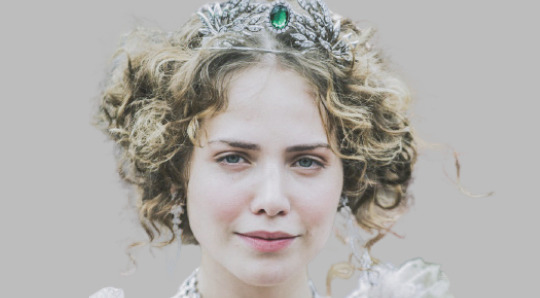
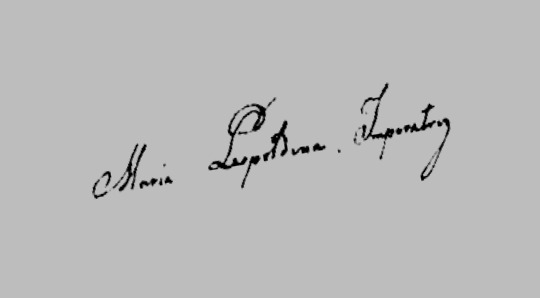
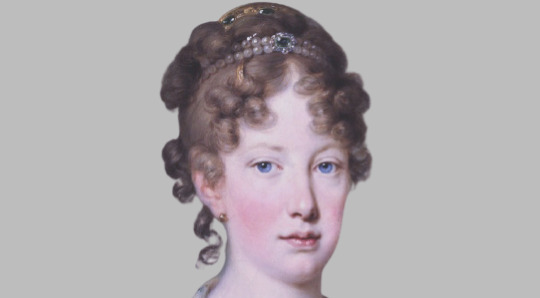
♕ JANUARY 22, 1797 – BIRTH OF MARIA LEOPOLDINA OF AUSTRIA, EMPRESS OF BRAZIL
Dona Maria Leopoldina of Austria (22 January 1797 – 11 December 1826) was born Caroline Josepha Leopoldine Franziska Ferdinanda of Habsburg-Lorraine at the Hofburg Palace in Vienna, Austria, Holy Roman Empire. She was the daughter of Holy Roman Emperor Franz II and Empress Maria Theresa of Naples and Sicily and among her siblings were Emperor Ferdinand I of Austria and Marie Louise of Austria, Empress of the French, the wife of Napoleon Bonaparte. In 1817 the Archduchess married Prince Dom Pedro of Braganza, heir to Portugal, later the Emperor Dom Pedro I of Brazil and King Dom Pedro IV of Portugal. The couple had 7 children: Queen Maria II of Portugal, Miguel, Prince of Beira, João Carlos, Prince of Beira, Princess Januária of Brazil, Princess Paula of Brazil, Princess Francisca of Brazil and Emperor Dom Pedro II of Brazil. During her time in Brazil Leopoldina gave advice to Dom Pedro in important political decisions that reflected in the future of the nation, such as the Dia do Fico and the subsequent opposition and disobedience to the Portuguese Cortes. She was one of the main articulators of the process of Independence of Brazil that took place between 1821 and 1822. On September 2, 1822 while she was the Acting Princess Regent of the Kingdom of Brazil in the absence of her husband Maria Leopoldina received a decree from Portugal that overturned the Brazilian government and demanded the immediate return of Pedro and his family to Lisbon. She summons the Council of State and signs on the same day the Decree of Independence, declaring Brazil separate from Portugal. Leopoldina send her husband the news, along with a letter urging him to proclaim the independence. On September 7, 1822 the letter reached Dom Pedro and he declared the independence of Brazil.
In 1826 Maria Leopoldina became Queen Consort of Portugal during her husband's brief reign as King Dom Pedro IV. Despite being usually remembered as a melancholic and humiliated woman by the extramarital affairs of Pedro I Leopoldina achieved much more. She had great influence in Brazilian politics and the respect and admiration of Brazilians, particurlarly of the poor and her popularity was even larger than that of Pedro. She died at age 29 on December 11, 1826 after a miscarriage. Maria Leopoldina was the first woman to govern an independent Brazil, the first empress consort of the country, the first empress of the Americas and the first woman to govern an independent American country.
Letícia Colin as Princess Maria Leopoldina of Austria, the Empress Consort of Brazil, Queen Consort of Portugal and Archduchess of Austria in “Novo Mundo” (2017).
#novo mundo#perioddramaedit#historyedit#weloveperioddrama#historicwomendaily#perioddramacentral#women in history#history#brazilian history#austrian history#period drama#maria leopoldina#maria leopoldina of austria#empress maria leopoldina#maria leopoldina of brazil#brasil#brazil#brazilian stuff#brazilian tv#mine#mine: edit#mine: novo mundo#mine: maria leopoldina#mine: novela#mine: brazilian tv#mine: brasil#novela#brazilian novela#novomundoedit
85 notes
·
View notes
Text
MARIE SOPHIE OF NEUBURG
Queen Consort of Portugal
(born 1666 - died 1699)

pictured above is a portrait of the Queen of Portugal, by António de Oliveira de Louredo from the 17th century
-------------------- ~ -------------------- ~ --------------------
SERIES - On this day August Edition: Marie Sophie died on 4 August 1699.
-------------------- ~ -------------------- ~ --------------------
MARIE SOPHIE ELISABETH was born in 1666, at Schloss Benrath in the Palatinate-Neuburg. She was one of the many daughters of Philipp Wilhelm, Count Palatine of Neuburg and his second wife Landgravine Elisabeth Amalie of Hesse-Darmstadt.
Born a member of the HOUSE OF WITTELSBACH from the Palatinate-Neuburg branch she was known by her father's title as COUNTESS MARIE SOPHIE OF THE PALATINATE-NEUBURG.
Her family was well known for great fertility as she had 17 siblings, and all of those who survived adulthood married within a variety of Royal Families throughout Europe.
She was the fourth sibling to get married. In 1687 she wed the widower PEDRO II, the King of Portugal and they had nine children (check the list below). He was the son of João IV, King of Portugal and Luisa de Guzmán. WIth his late wife Princess Marie-Françoise of Savoy he already have had one daughter.
At least three of Palatinate-Neuburg siblings' marriages were arranged do to her family's fertility fame, as her husband and two of her brothers-in-law Leopold I, Holy Roman Emperor and Carlos II, King of Spain had no surviving male heirs from previous marriages.
While in Portugal she was known as MARIA SOFIA, QUEEN CONSORT OF PORTUGAL.
By 1696 her father inherited the County Palatine of the Rhine (known as the Electorate of the Palatinate) from a distant relative. So her family was raised in status as her father became a Prince-Elector of the Holy Roman Empire.
On 4 August 1699, aged only 32, the Queen Consort of Portugal died at the Ribeira Palace in Lisbon.
-------------------- ~ -------------------- ~ --------------------
In Portugal her descendants ruled until the Abolishion of the Monarchy in 1910 and they also became Emperors of Brazil.
-------------------- ~ -------------------- ~ --------------------
MARIE SOPHIE and her husband PEDRO II had nine children...
João, Prince of Brazil - died aged eighteen days old;
João V, King of Brazil - husband of Archduchess Maria Anna of Austria;
Francisco, Duke of Beja - unmarried;
a stillborn daughter;
Infanta Francisca Xaviera of Portugal - died within her first month;
Infante António of Portugal - unmarried;
Infanta Teresa Maria of Portugal - died aged seven;
Manuel, Count of Ourém - unmarried; and
Infanta Francisca Josefa of Portugal - unmarried.
#marie sophie of neuburg#queen consort of portugal#palatinate neuburg#kingdom of portugal#german royals#german nobility#royals#royalty#monarchy#monarchies#royal history#german history#european history#world history#history#17th century#pedro ii#portuguese royalty#history with laura
20 notes
·
View notes
Text
Events 1.1 (before 1830)
153 BC – For the first time, Roman consuls begin their year in office on January 1.
45 BC – The Julian calendar takes effect as the civil calendar of the Roman Empire, establishing January 1 as the new date of the new year.
42 BC – The Roman Senate posthumously deifies Julius Caesar.
193 – The Senate chooses Pertinax against his will to succeed Commodus as Roman emperor.
404 – Saint Telemachus tries to stop a gladiatorial fight in a Roman amphitheatre, and is stoned to death by the crowd. This act impresses the Christian Emperor Honorius, who issues a historic ban on gladiatorial fights.
417 – Emperor Honorius forces Galla Placidia into marriage to Constantius, his famous general (magister militum) (probable).
947 – Emperor Tai Zong of the Khitan-led Liao Dynasty captures Daliang, ending the dynasty and empire of the Later Jin.
1001 – Grand Prince Stephen I of Hungary is named the first King of Hungary by Pope Sylvester II (probable).
1068 – Romanos IV Diogenes marries Eudokia Makrembolitissa and is crowned Byzantine Emperor.
1259 – Michael VIII Palaiologos is proclaimed co-emperor of the Empire of Nicaea with his ward John IV Laskaris.
1438 – Albert II of Habsburg is crowned King of Hungary.
1500 – Portuguese explorer Pedro Álvares Cabral discovers the coast of Brazil.
1502 – The present-day location of Rio de Janeiro, Brazil, is first explored by the Portuguese.
1515 – Twenty-year-old Francis, Duke of Brittany, succeeds to the French throne following the death of his father-in-law, Louis XII.
1527 – Croatian nobles elect Ferdinand I, Archduke of Austria as King of Croatia in the 1527 election in Cetin.
1600 – Scotland recognises January 1 as the start of the year, instead of March 25.
1604 – The Masque of Indian and China Knights is performed by courtiers of James VI and I at Hampton Court.
1651 – Charles II is crowned King of Scotland at Scone Palace.
1700 – Russia begins using the Anno Domini era instead of the Anno Mundi era of the Byzantine Empire.
1707 – John V is proclaimed King of Portugal and the Algarves in Lisbon.
1739 – Bouvet Island, the world's remotest island,[21] is discovered by French explorer Jean-Baptiste Charles Bouvet de Lozier.
1772 – The first traveler's cheques, which could be used in 90 European cities, are issued by the London Credit Exchange Company.
1773 – The hymn that became known as "Amazing Grace", then titled "1 Chronicles 17:16–17, Faith's Review and Expectation", is first used to accompany a sermon led by John Newton in the town of Olney, Buckinghamshire, England.
1776 – American Revolutionary War: Norfolk, Virginia is burned by combined Royal Navy and Continental Army action.
1776 – General George Washington hoists the first United States flag, the Grand Union Flag, at Prospect Hill.
1781 – American Revolutionary War: One thousand five hundred soldiers of the 6th Pennsylvania Regiment under General Anthony Wayne's command rebel against the Continental Army's winter camp in Morristown, New Jersey in the Pennsylvania Line Mutiny of 1781.
1788 – The first edition of The Times of London, previously The Daily Universal Register, is published.
1801 – The legislative union of Kingdom of Great Britain and Kingdom of Ireland is completed, and the United Kingdom of Great Britain and Ireland is proclaimed.
1801 – Ceres, the largest and first known object in the Asteroid belt, is discovered by Giuseppe Piazzi.
1804 – French rule ends in Haiti. Haiti becomes the first black-majority republic and second independent country in North America after the United States.
1806 – The French Republican Calendar is abolished.
1808 – The United States bans the importation of slaves.
1810 – Major-General Lachlan Macquarie officially becomes Governor of New South Wales.
1822 – The Greek Constitution of 1822 is adopted by the First National Assembly at Epidaurus.
0 notes